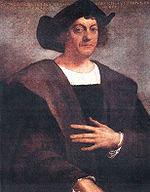

http://www.bookpage.com/0506bp/nonfiction/lastvoyageofcolumbus.html
Discoveries in thuis age of exploration of the new world were in reality quests for gold and and exports for obtaining raw materials and colonies, and the avarice for these goods and materials came in and along with much feigned or genuine missionary zeal. The accounts of the indigenous peoples encountered and the genuine documentary sources proved fascinating for the scholar to read and for the moralist to study the perennial lessons brought to the fore.
- Accounts of Swordfight, Mutiny, Shipwreck, Gold, War, Hurricane, and Discovery. By Martin Dugard
- 16th century competitive mercantile politics with unfeigned avarice at the core of their dealings, foremost and pervasive.
- Columbus tries to legitimize his quest and continues to search finally in 1502 for the elusive passage to India which he never finds and he tinges all with his his intense religious piety as is shown in the tv production.
- The Panamanian jungle scam to procure victuals for survival with the gullible indigenous peoples exhibited his knowledge of the heavens and seas . he consulted an astronomy text and told the Indians ''God would send them a clear token from heaven of the punishment they were about to receive'' if they didn't cough up the daily victuals; right on schedule a lunar eclipse came, the Indians cried for mercy, and that was that.
- rely on ships' logs, journals, letters and other contemporary accounts, letting the participants describe these extraordinary adventures themselves. These sources show the author's scholarly and thoroughgoing approach. I will access the book for other "engrossing" contemporaneous accounts.
- Note the review by James Webb and the further insights revealed. The wreckage of the La Vizcaina in Panama and the unstoppable flow of humanity to the new world for a variety of motivations many of them nefarious.
THE LAST VOYAGE OF COLUMBUS: Being the Epic Tale of the Great Captain's
Fourth Expedition, Including Accounts of Swordfight, Mutiny, Shipwreck, Gold,
War, Hurricane, and Discovery. By Martin Dugard. (Little, Brown, $24.95.) Vast
new lands, strange new peoples, Edenic flora and fauna aside, Columbus's four
voyages to the new world were commercial enterprises, with a nervous Spanish
court expecting a return on its investment. In a rich, fluent account, Dugard
offers both a gripping naval adventure and a revealing history of the
competitive mercantile politics of the turn of the 16th century, and portrays
Columbus as a star-crossed striver eager to legitimize his quest. Reined in by
hard-nosed administrators and for a time imprisoned for failing to maintain
order in the critical outpost of Santo Domingo, the Admiral of the Ocean Sea
made a final, desperate attempt in 1502 to find that elusive passage to India.
Perhaps he knew it was doomed when, while searching for gold in the lush
Panamanian jungle, a scout was told by angry inhabitants that ''these people
were going to burn our ships and kill us all,'' a threat they nearly carried
out. The leaking fleet escaped, only to be marooned in Jamaica for a year. But
Columbus's ingenuity never failed him. In an archetypal high-seas scam, when the
local tribe in Jamaica began to cut off the castaways' food supply, he consulted
an astronomy text and told the Indians ''God would send them a clear token from
heaven of the punishment they were about to receive'' if they didn't cough up
the daily victuals; right on schedule a lunar eclipse came, the Indians cried
for mercy, and that was that. Dugard's detailed reconstructions, while sometimes
far-fetched (how could he know that Columbus's prison shackles were ''clattering
lightly'' as he wrote an apology to Ferdinand and Isabella?), rely on ships'
logs, journals, letters and other contemporary accounts, letting the
participants describe these extraordinary adventures themselves.Sailing with Columbus
REVIEW BY JAMES NEAL WEBB
While the main events of history paint the picture of our past in broad strokes, it is often the lesser known stories that fill in the details and enrich our understanding of events. The Last Voyage of Columbus, a new book by Martin Dugard, is of the latter variety, and in it we find a figure who, while familiar, is more human and thus more interesting than the Christopher Columbus we know from history textbooks.
Columbus is, in many ways, one of the most complex and enigmatic figures in human history. While certainly a man of vision, he was also stubborn to the point of absurdity; he was a superb navigator and sailor who often had trouble with the sailors he led; he was handsome and charming, so much so that if Queen Isabella had been other than the devout Catholic she was, he could have been her lover.
Dugard's portrait of Columbus has its origins in the discovery of an ancient shipwreck at the mouth of a river in Panama. While the evidence is inconclusive, it is possible that the wreckage is that of the La Vizcaina, one of four ships Columbus took on his fourth trip to the New World. This journey was more than Columbus' last voyage—it was his last shot. While Columbus fancied himself the administrator of all the lands he discovered, in truth there was nothing he could do to stop the flood of humanity to the New World. His only chance at everlasting glory (he thought) was to find China, or at least discover a way to get there. In pursuit of that goal, Columbus endured becalmed seas, hostile natives, a horrific hurricane and eventually a devastating shipwreck before finally making his way home to die two years later.
As Dugard shows us in this remarkable book, while Columbus may have thought himself a failure, and while he remained virtually unremembered for a couple of centuries thereafter (Amerigo Vespucci was mistakenly credited with the discovery), the truth finally resurfaced. And amazingly, the wrecked ship in Panama tells us that Columbus may have come within 38 miles of seeing his goal, the Pacific Ocean.



No comments:
Post a Comment